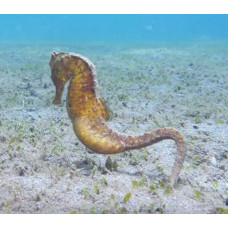Latin name
Hippocampus kuda
Other name
Estuary seahorse, yellow seahorse, spotted seahorse, sea pony.
Identification
Body rather large, elongated, without spines, all convexities rounded. The head is relatively large in proportion to the body. The muzzle is short and thick. The scopus is small and raised towards the back, sometimes it may have more or less long filaments. There is a tail used for bending and grasping.
Fish colouring
Some adults have a black line across the width of the dorsal fin. The body coloration is often dark with a grainy texture, but can also be yellow, cream, or reddish with flecks and numerous small dark spots.
Distribution
Occurs in waters from the Persian Gulf to Southeast Asia, Australia, Japan and several Pacific islands, including Hawaii, and the east coast of Africa from Tanzania to South Africa, including the Indo-Pacific region from the northwestern Indian Ocean to the central Pacific. A large proportion of H. kuda lives along the coast of China as far north as Australia.
Habitat
H. kuda inhabit estuaries, lagoons, harbors, coastal areas, and seagrass beds, where they can be found in shallow waters up to fifty-five meters deep. Their habitats may include (but are not limited to) tropical, saline, or marine regions.
Size
A small fish that can reach a length of 17-30 cm.
Behavior
This seahorse is able to bend its tail in the abdomen due to the presence of plates on its body. The hypoxia muscle is responsible for bending the seahorse's tail. The plates transmit force to the hypoxia muscle to allow the tail to bend.
Food and feeding habits
They are omnivorous and feed by sucking small live prey such as fish larvae and zooplankton. They are not good swimmers.
Reproduction
The mating system of H. kuda is completely monogamous. Before mating, this species performs a unique courtship ritual. The male changes color and dances around the female while making flickering noises with his crown. Eventually, the tails of the male and female intertwine and the female lays eggs through the ovipositor into the male's abdominal brood pouch. A single pouch can contain up to a thousand eggs, which can take twenty to twenty-eight days to develop. Birth, however, depends largely on the nature of the monsoon rains, lunar cycles, and water temperature. For males, births usually begin on the full moon, and after birth, baby seahorses reach an average length of seven millimeters.
Fishing
Fishermen target this species for aquariums and traditional medicine.
Relationship with a person
Seahorses are extremely valuable in traditional Chinese medicine. They are believed to regulate the nervous, reproductive, endocrine and immune systems. Every year, 25 million seahorses are used for medicinal purposes. The largest known exporters are Vietnam, India, the Philippines and Thailand. It is a very popular species among aquarists.
| Classification | |
| Phylum | Chordata |
| Class | Actinopterygii |
| Squad | Syngnathiformes |
| Family | Syngnathidae |
| Genus | Hippocampus |
| Species | H. kuda |
| Features | |
| Conservation status | Vulnerable |
| Habitat | Pelagic |
| Life span, years | No information |
| Maximum body weight, kg | No information |
| Maximum length, cm | 30 |
| Sailing speed, m/s | No information |
| Threat to people | Not edible |
| Way of eating | Planktonophage |
Common seahorse
Tags: common seahorse



